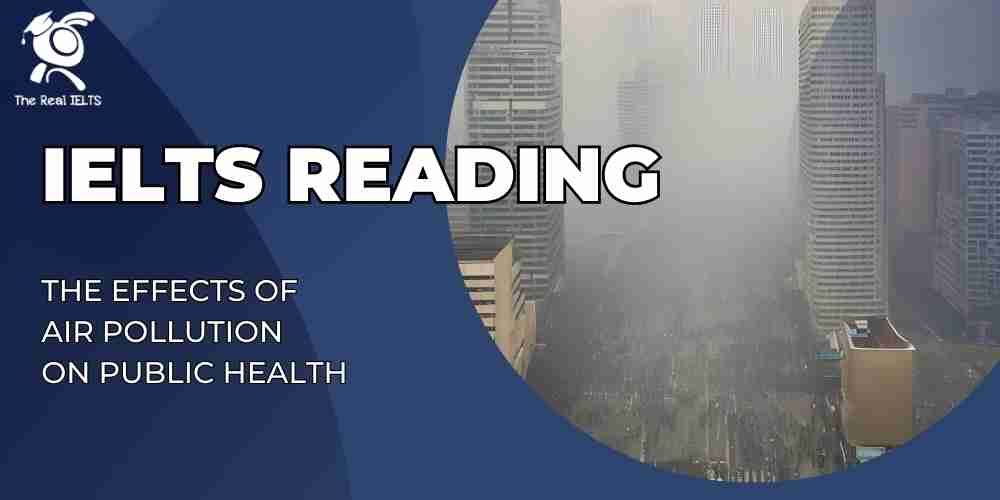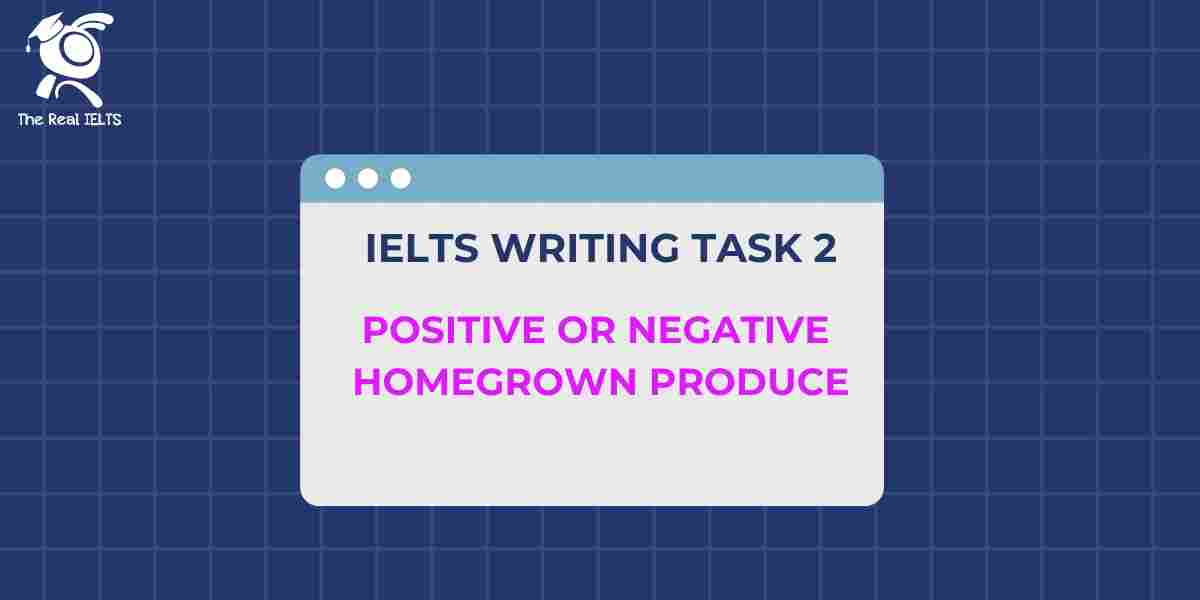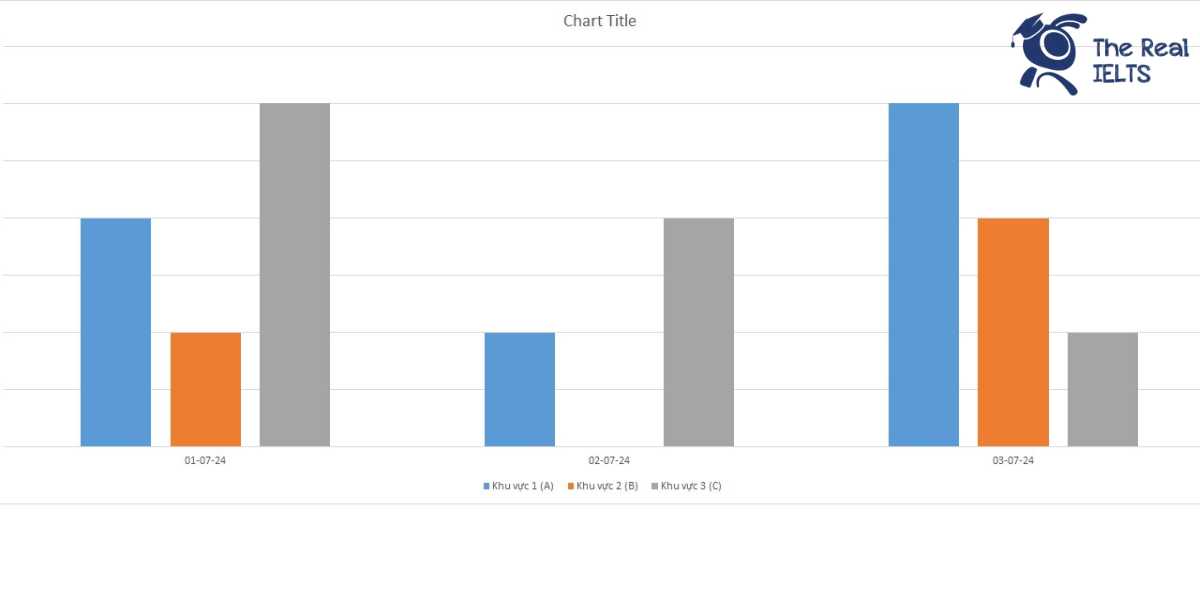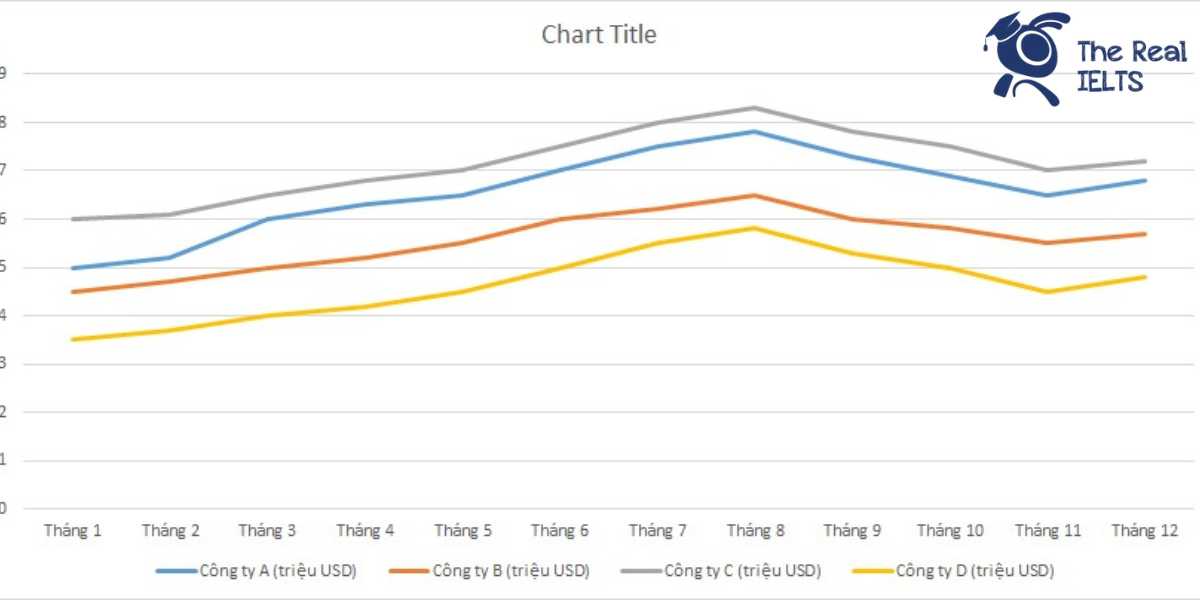Luyện tập IELTS Reading ngày 27 có chủ đề: The Effects of Air Pollution on Public Health. Bài này thuộc chuỗi IELTS Reading: 30 chủ đề luyện tập. Mỗi bài này luyện tập khoảng 30 phút.
Học lại bài cũ: IELTS READING Day 26: Global Migration Patterns and Their Socio-Economic Impact.
Đọc bài IELTS Reading và trả lời câu hỏi ở bên dưới
Air pollution is a significant environmental issue with far-reaching consequences on public health. It refers to the presence of harmful substances in the atmosphere, including particulate matter, nitrogen dioxide, sulfur dioxide, carbon monoxide, and volatile organic compounds. These pollutants are often released by industrial processes, vehicle emissions, and the burning of fossil fuels. The effects of air pollution on human health are profound, impacting various bodily systems and leading to both short-term and long-term health problems. Understanding these effects is critical for public health initiatives and policy development.
Respiratory Health Impacts
One of the most direct effects of air pollution is on the respiratory system. Inhalation of polluted air, especially particulate matter (PM), can lead to irritation of the airways, inflammation, and reduced lung function. Fine particles, such as PM2.5, are small enough to penetrate deep into the lungs and even enter the bloodstream, causing significant harm. In the short term, exposure to high levels of air pollution can trigger asthma attacks, bronchitis, and other respiratory conditions, particularly in vulnerable populations such as children, the elderly, and individuals with pre-existing respiratory diseases. Long-term exposure to air pollution is associated with chronic respiratory diseases like chronic obstructive pulmonary disease (COPD) and lung cancer, both of which can significantly reduce life expectancy.
Cardiovascular Effects
The cardiovascular system is also highly susceptible to the effects of air pollution. Research has demonstrated that air pollutants, particularly fine particulate matter, can contribute to inflammation and oxidative stress in blood vessels, which increases the risk of heart disease. Air pollution has been linked to the development and exacerbation of hypertension, atherosclerosis (hardening of the arteries), and heart attacks. Long-term exposure to pollutants like nitrogen dioxide and carbon monoxide is associated with a higher risk of stroke and other cardiovascular events. These effects are particularly dangerous for individuals who already suffer from heart disease or high blood pressure, as air pollution can trigger acute events such as heart attacks and strokes.
Impact on Children’s Health
Children are particularly vulnerable to the harmful effects of air pollution. Since their lungs are still developing, exposure to high levels of pollutants during childhood can lead to long-term respiratory problems. Studies have shown that children living in areas with high air pollution are more likely to suffer from asthma and reduced lung growth. Furthermore, there is growing evidence suggesting that prenatal exposure to air pollution can affect fetal development, potentially leading to low birth weight, premature birth, and developmental delays. The early onset of respiratory conditions in children due to air pollution increases the likelihood of them suffering from chronic diseases later in life.
Air Pollution and Mortality
Air pollution is a major contributor to premature mortality worldwide. According to the World Health Organization (WHO), air pollution is responsible for approximately 7 million deaths each year. These deaths are primarily attributed to diseases such as stroke, heart disease, lung cancer, and chronic respiratory diseases, all of which are exacerbated by poor air quality. In urban areas, where pollution levels tend to be higher due to traffic and industrial activities, the health burden is particularly significant. Mortality rates are notably higher in regions where air pollution regulations are lax or poorly enforced, emphasizing the need for stricter policies to improve air quality.
Neurological and Cognitive Effects
Emerging research indicates that air pollution may also have detrimental effects on the brain. Prolonged exposure to polluted air has been associated with cognitive decline, including a higher risk of neurodegenerative diseases such as Alzheimer’s and Parkinson’s disease. Fine particulate matter is believed to contribute to neuroinflammation, which may lead to cognitive impairments. Additionally, children exposed to high levels of air pollution have been shown to experience delays in cognitive development, affecting their academic performance and overall intellectual growth. Although research in this area is still ongoing, the potential link between air pollution and neurological health highlights another critical dimension of the public health crisis caused by air pollution.
Social and Economic Implications
The health impacts of air pollution also have broader social and economic implications. Increased healthcare costs associated with treating pollution-related diseases place a heavy burden on both individuals and healthcare systems. In developing countries, where air pollution levels tend to be higher, these costs can be particularly devastating. Moreover, air pollution-related illnesses contribute to reduced productivity, as individuals suffering from respiratory or cardiovascular issues may miss work or be less productive in their daily activities. This loss of productivity has far-reaching consequences for economies, particularly in regions where air pollution levels are consistently high.
Mitigation and Prevention Strategies
Efforts to mitigate the effects of air pollution on public health require both individual and collective action. On a policy level, governments must enforce stricter air quality standards and reduce emissions from industrial sources and vehicles. Investments in clean energy, public transportation, and sustainable urban development are crucial to reducing overall pollution levels. Public awareness campaigns can educate individuals about the dangers of air pollution and encourage behaviors that reduce personal exposure, such as avoiding outdoor activities during high pollution days and using air purifiers indoors.
On an individual level, people can take steps to protect themselves from air pollution by wearing masks, especially in areas with high particulate matter, and minimizing outdoor exercise during periods of poor air quality. Additionally, supporting environmental initiatives and advocating for stronger pollution controls can help ensure cleaner air for future generations.
Conclusion
Air pollution poses a significant threat to public health, affecting respiratory, cardiovascular, and neurological systems, while also contributing to premature mortality and economic burdens. The widespread and multifaceted effects of air pollution underscore the urgent need for stronger environmental regulations and public health interventions. Addressing this issue requires cooperation between governments, industries, and individuals to create healthier environments and reduce the global health burden caused by polluted air.
Từ vựng
- Air pollution – Ô nhiễm không khí
- Substances – Chất
- Particulate matter – Vật chất hạt (bụi mịn)
- Nitrogen dioxide – Nitơ điôxít
- Sulfur dioxide – Lưu huỳnh điôxít
- Carbon monoxide – Cacbon monoxít
- Volatile organic compounds – Hợp chất hữu cơ dễ bay hơi
- Bodily systems – Hệ thống cơ thể
- Respiratory system – Hệ hô hấp
- Irritation – Kích ứng
- Inflammation – Viêm nhiễm
- Lung function – Chức năng phổi
- Bloodstream – Dòng máu
- Asthma – Hen suyễn
- Bronchitis – Viêm phế quản
- Chronic respiratory diseases – Bệnh hô hấp mãn tính
- Chronic obstructive pulmonary disease (COPD) – Bệnh phổi tắc nghẽn mãn tính
- Lung cancer – Ung thư phổi
- Life expectancy – Tuổi thọ
- Cardiovascular system – Hệ tim mạch
- Inflammation and oxidative stress – Viêm nhiễm và stress oxy hóa
- Blood vessels – Mạch máu
- Hypertension – Huyết áp cao
- Atherosclerosis – Xơ vữa động mạch
- Heart attacks – Đau tim
- Stroke – Đột quỵ
- Prenatal exposure – Tiếp xúc trước khi sinh
- Fetal development – Sự phát triển của thai nhi
- Premature birth – Sinh non
- Developmental delays – Chậm phát triển
- Premature mortality – Tử vong sớm
- Neurodegenerative diseases – Bệnh thoái hóa thần kinh
- Neuroinflammation – Viêm thần kinh
- Cognitive development – Phát triển nhận thức
- Public health crisis – Khủng hoảng sức khỏe cộng đồng
- Healthcare costs – Chi phí chăm sóc y tế
- Productivity – Năng suất
- Sustainable urban development – Phát triển đô thị bền vững
- Public awareness campaigns – Chiến dịch nâng cao nhận thức cộng đồng
- Air quality standards – Tiêu chuẩn chất lượng không khí
- Pollution controls – Kiểm soát ô nhiễm
- Premature mortality – Tử vong sớm
- Environmental regulations – Quy định về môi trường
Câu hỏi IELTS Reading
1. Multiple Choice Questions (MCQ):
- What is one of the main pollutants mentioned in the article that affects the respiratory system? A. Oxygen
B. Carbon dioxide
C. Particulate matter
D. Methane - According to the passage, which group of people is most vulnerable to the effects of air pollution? A. Athletes
B. Children and the elderly
C. Office workers
D. Tourists - Long-term exposure to air pollution can increase the risk of which of the following diseases? A. Asthma
B. Hypertension
C. Cancer
D. All of the above
2. True/False/Not Given:
- True / False / Not Given: Air pollution has no significant impact on cognitive development in children.
- True / False / Not Given: Air pollution affects only the respiratory system, according to the article.
- True / False / Not Given: The article suggests that healthcare costs are increasing due to pollution-related diseases.
3. Matching Information:
Match the effects of air pollution to the corresponding health impact:
- Asthma attacks –
- Heart disease –
- Premature birth –
- Cognitive decline –A. Cardiovascular effects
B. Respiratory effects
C. Neurological effects
D. Prenatal effects
4. Short Answer Questions:
- What are two common sources of air pollution mentioned in the article?
- How does fine particulate matter (PM2.5) affect the human body?
- What strategies can individuals use to protect themselves from air pollution?
- According to the article, what are some social and economic consequences of air pollution?
5. Sentence Completion:
- Air pollution can contribute to inflammation in the ___________, increasing the risk of cardiovascular diseases.
- Children exposed to high levels of pollution are more likely to suffer from ___________ and reduced lung growth.
- Emerging research indicates that long-term exposure to polluted air may lead to ___________ and neurodegenerative diseases.
- The healthcare costs of treating pollution-related illnesses can place a heavy burden on ___________ and healthcare systems.
Đáp án IELTS Reading
1. Multiple Choice Questions (MCQ):
- C. Particulate matter
- B. Children and the elderly
- D. All of the above
2. True/False/Not Given:
- False (The article mentions that air pollution can have detrimental effects on cognitive development in children.)
- False (The article discusses air pollution’s effects on multiple systems, including respiratory, cardiovascular, and neurological systems.)
- True (The article states that increased healthcare costs are associated with treating pollution-related diseases.)
3. Matching Information:
- B. Respiratory effects (Asthma attacks)
- A. Cardiovascular effects (Heart disease)
- D. Prenatal effects (Premature birth)
- C. Neurological effects (Cognitive decline)
4. Short Answer Questions:
- Two common sources of air pollution mentioned in the article are vehicle emissions and industrial processes.
- Fine particulate matter (PM2.5) affects the body by penetrating deep into the lungs and entering the bloodstream, causing inflammation and reduced lung function.
- Individuals can protect themselves from air pollution by wearing masks and minimizing outdoor activities during high pollution days.
- Some social and economic consequences of air pollution include increased healthcare costs and reduced productivity.
5. Sentence Completion:
- Air pollution can contribute to inflammation in the blood vessels, increasing the risk of cardiovascular diseases.
- Children exposed to high levels of pollution are more likely to suffer from asthma and reduced lung growth.
- Emerging research indicates that long-term exposure to polluted air may lead to cognitive decline and neurodegenerative diseases.
- The healthcare costs of treating pollution-related illnesses can place a heavy burden on individuals and healthcare systems.















